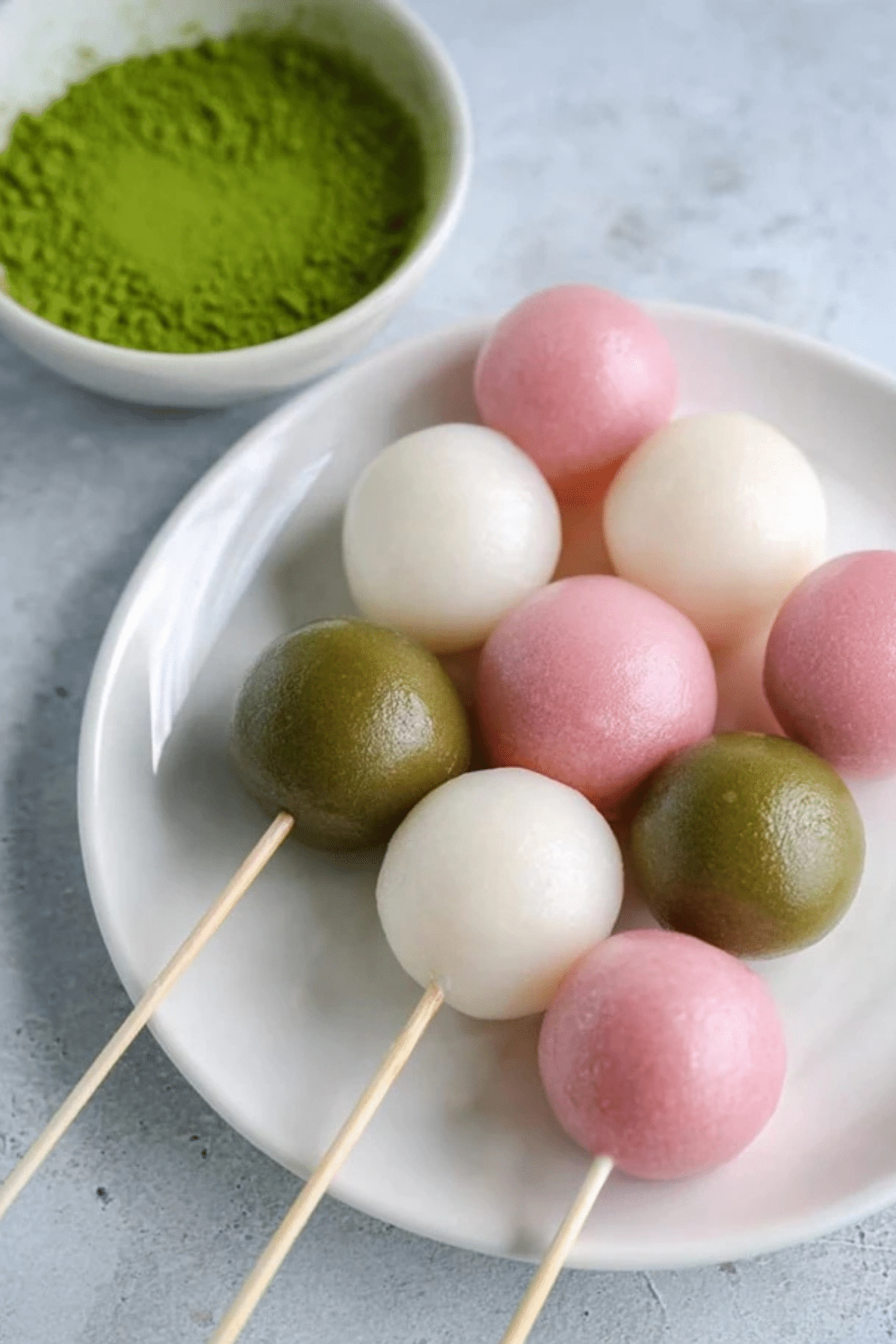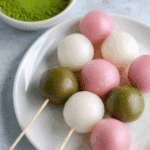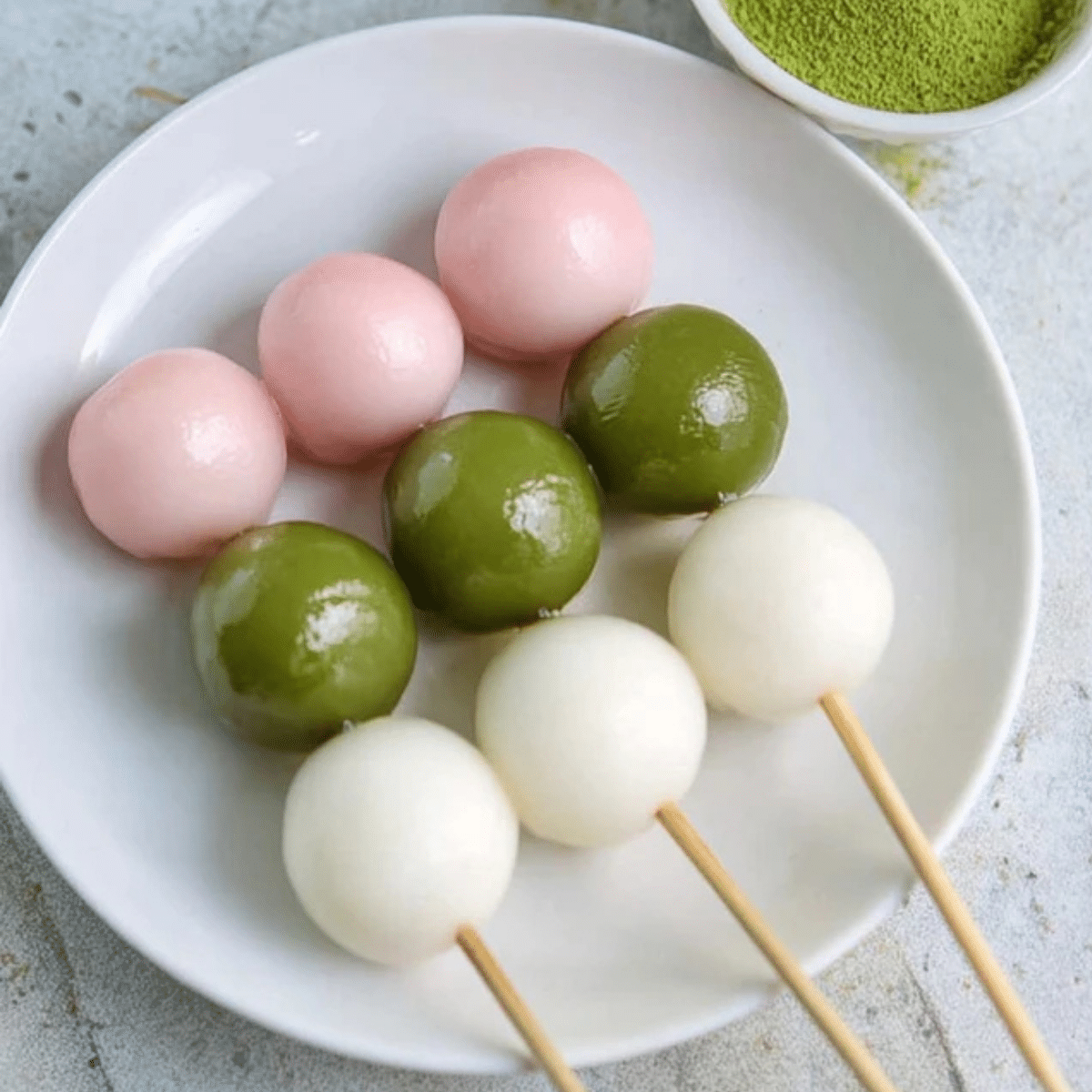Dango is a classic Japanese dessert that combines chewy rice flour balls with vibrant colors and delightful flavors. This easy Hanami Dango recipe brings together the perfect balance of sweetness and texture. These rice flour-based treats are ideal for celebrating the spring season, especially during the cherry blossom viewing, known as Hanami. Whether you’re new to Japanese desserts or an experienced enthusiast, this dango recipe will impress with its simple preparation and vibrant presentation.
Table of Contents
Why This Hanami Dango Recipe Is So Popular
This Hanami Dango recipe is incredibly easy to make, even for beginners. With just a handful of ingredients and minimal steps, you can enjoy these chewy, colorful rice flour balls in no time. The beauty of this recipe lies in its simplicity. The use of glutinous rice flour gives the dango its signature chewy texture, while the addition of matcha and food coloring creates vibrant, visually appealing results. This dessert is perfect for spring, especially when paired with savory Japanese dishes like Hibachi Fried Rice or Crispy Shrimp Tempura.
Ingredients
Here’s what you’ll need for this easy Hanami Dango recipe:
- Joshinko glutinous rice flour: This forms the base of the dango, providing the chewy texture.
- Shiratamako glutinous sweet rice flour: Adds sweetness and contributes to the soft, tender texture.
- Powdered sugar: Optional, but helps sweeten the dango for a more dessert-like treat.
- Hot water: Used to combine the rice flours and form the dough.
- Matcha powder: For flavor and a vibrant green color.
- Pink food coloring: For the soft pink hue representing cherry blossoms.
Alternative Ingredient Suggestions
If you’re looking for a variation of this Hanami Dango recipe, consider these options:
- Substitute silken tofu for water: If you prefer a softer, melt-in-your-mouth texture, replace the water with silken tofu. This will give the dango a smoother consistency.
- Use natural coloring: For a more natural approach, you can use beet juice for pink and spinach powder for green.
Step-by-Step Instructions
Making Hanami Dango is simple and fun! Just follow these steps to create perfect, chewy rice flour balls:
- Soak the skewers: Start by soaking 12 bamboo skewers in water for at least 30 minutes to prevent them from burning.
- Mix the rice flour: In a bowl, combine the Joshinko and Shiratamako rice flours. Gradually add hot water, stirring with a spoon to form a dough. Once the mixture starts to come together, knead it with your hands until it feels like soft playdough. Adjust the consistency by adding more flour or water if necessary.
- Divide and color the dough: Divide the dough into three equal portions. Add one drop of pink food coloring to one portion, and mix until the color is evenly distributed. For the green portion, dissolve 1 teaspoon of matcha powder in 1 teaspoon of water, then add it to the dough. Leave the third portion of dough plain (white).
- Shape the dough: Use a kitchen scale to measure out 20 grams of dough for each ball. Roll them into smooth, round balls. You should end up with about 36 dango balls in total.
- Cook the dango: Bring a pot of water to a boil. First, cook the white dango balls. When they float to the surface, cook for an additional 2 minutes. Transfer them to a bowl of ice water to cool. Repeat this process for the pink and green dango balls, cooking them in that order to avoid color contamination.
- Skewer the dango: Once all the dango are cooled, thread them onto the soaked bamboo skewers. Start with the green dango, followed by the white, and finish with the pink dango. This order mimics the colors of spring, with green representing grass, white for winter snow, and pink for cherry blossoms.

Tips & Tricks
Here are some helpful tips to ensure your Hanami Dango turns out perfectly:
- Soak skewers beforehand: Soaking bamboo skewers in water prevents them from splintering and makes it easier to slide the dango balls onto them.
- Measure carefully: For the best texture, use a kitchen scale to measure your ingredients and the size of each dango ball. This ensures consistency in both texture and cooking time.
- Use tofu for a softer dango: If you prefer your dango softer and more delicate, replace the water with silken tofu to achieve a smoother texture.
- Cook the dango in the correct order: Start with the white dango, followed by the pink, and finish with the green dango. This prevents the colors from bleeding into each other during cooking.
Pairing Ideas and Variations
Hanami Dango can be enjoyed as-is, but it pairs beautifully with various toppings and sides:
- Toppings: Try sweet soy glaze, red bean paste, or matcha paste to enhance the flavor.
- Side dishes: Hanami Dango makes a great dessert after savory Japanese dishes such as Shrimp Tempura, Hibachi Fried Rice, or a bowl of miso soup.
- Make-ahead: You can prepare the dango ahead of time and store them in an airtight container at room temperature for up to two days. Avoid refrigerating them, as it can cause the dango to become tough.
Why Hanami Dango Is a Symbol of Spring
Hanami Dango is more than just a delicious dessert; it’s a symbol of the spring season in Japan. During cherry blossom viewing, people gather to appreciate the fleeting beauty of the cherry blossoms, and Hanami Dango is often enjoyed as a part of these celebrations. The colors of the dango—green, white, and pink—represent the natural changes that occur during spring: the green of grass, the white of snow, and the pink of blooming cherry blossoms.
Conclusion
Hanami Dango is a delightful Japanese treat that beautifully combines flavor, texture, and tradition. Whether you’re preparing this colorful dessert for a special spring celebration or just looking to try something new in the kitchen, this easy recipe is sure to impress. With its chewy rice flour balls and vibrant hues, Hanami Dango makes for a fun and festive addition to any meal or gathering. So, gather your ingredients and enjoy the sweet simplicity of this seasonal Japanese dessert.
Frequently Asked Questions (FAQs)
1. What is Hanami Dango?
Hanami Dango is a traditional Japanese dessert often enjoyed during the cherry blossom season, symbolizing the arrival of spring. The colorful rice flour balls are typically skewered and served with three vibrant colors: pink, white, and green. The pink represents cherry blossoms, white symbolizes winter snow, and green stands for the grass of summer.
2. Can I make Hanami Dango without food coloring?
Yes, you can! While food coloring gives the dango its traditional vibrant look, you can opt for natural coloring agents. For example, beet juice can be used for the pink color, and spinach powder or matcha can provide the green hue. These alternatives will give your dango a more natural, earthy appearance.
3. How do I store leftover Hanami Dango?
To store Hanami Dango, place it in an airtight container at room temperature for up to two days. Avoid refrigerating, as the dango can become tough and lose its soft texture. If you want to keep it longer, freeze the dango and reheat it when needed.
4. What is the difference between Dango and Mochi?
While both Dango and Mochi are made with glutinous rice, they differ in texture and preparation. Mochi is made with pounded sticky rice, giving it a dense and chewy texture. Dango, on the other hand, is made with rice flour (such as Shiratamako or Joshinko), resulting in a firmer, slightly chewy texture. These two desserts cannot be substituted for one another in recipes.
More Relevant Recipes
- Easy Sticky Chicken Rice Bowls: This recipe offers a savory and slightly sweet chicken dish served over rice, similar to the Japanese flavor profiles found in Hanami Dango. The rich glaze pairs well with the chewy texture of the rice, creating a satisfying meal.
- Creamy Sausage Tortellini Soup: For those who enjoy comforting and creamy flavors, this rich soup combines sausage and tortellini, offering a hearty and indulgent dish. Its smooth texture and savory taste make it a comforting contrast to the chewy sweetness of Hanami Dango.
- Easy Honey Garlic Shrimp with Sausage and Broccoli: A delightful combination of savory sausage, sweet honey garlic shrimp, and tender broccoli. This dish provides a balance of flavors, offering a light yet flavorful meal that pairs well with the sweet and chewy texture of Dango.

Dango Recipe
- Total Time: 45 minutes
- Yield: 36 dango balls (12 skewers)
- Diet: Vegetarian
Description
This easy Hanami Dango recipe features chewy, colorful rice flour balls, traditionally enjoyed during Japan’s cherry blossom season. With three vibrant colors—pink, white, and green—Hanami Dango symbolizes spring and offers a deliciously sweet treat that’s perfect for any seasonal celebration.
Ingredients
- 1 1/3 cups Joshinko glutinous rice flour (150 g)
- 1 1/2 cups Shiratamako glutinous sweet rice flour (200 g)
- 3/4 cup powdered sugar (75 g), optional for added sweetness
- 1 1/3 cups hot water
- 1 teaspoon matcha powder
- 1 teaspoon water (for matcha paste)
- 1 drop pink food coloring
Instructions
- Soak 12 bamboo skewers in water for at least 30 minutes.
- In a bowl, combine the Joshinko and Shiratamako rice flours. Gradually add hot water, stirring with a spoon, and then knead the dough by hand until it feels like soft playdough.
- Divide the dough into three equal portions and place each into separate bowls.
- Add 1 drop of pink food coloring to one portion of dough and mix until fully incorporated.
- Mix 1 teaspoon of water with 1 teaspoon of matcha powder to create a paste. Add this paste to the second portion of dough and knead until the green color is evenly distributed.
- Leave the third portion of dough plain (white).
- Use a kitchen scale to measure 20 grams of dough per ball. Roll each portion of dough into smooth, round balls.
- Bring a pot of water to a boil and cook the white dango balls first. Once they float, cook for an additional 2 minutes and transfer them to ice water to cool.
- Repeat the cooking process for the pink and green dango balls, starting with the pink and finishing with the green to avoid color contamination in the water.
- Skewer the dango, starting with the green, followed by the white, and finishing with the pink.
Notes
- Soaking the bamboo skewers is essential for easy threading of the dango balls.
- Accurately measure the dough portions using a kitchen scale for consistency in size.
- If you prefer a softer texture, substitute the hot water with silken tofu.
- Cook the dango in the correct order: white, pink, green, to prevent the water from staining.
- For a natural color alternative, consider using beet juice for pink and spinach powder for green.
- Prep Time: 30 minutes
- Cook Time: 15 minutes
- Category: Dessert
- Method: Boiling, Skewering
- Cuisine: Japanese
Nutrition
- Serving Size: 1 skewer (3 balls)
- Calories: 168 kcal
- Sugar: 7 g
- Sodium: 1 mg
- Fat: 1 g
- Saturated Fat: 1 g
- Unsaturated Fat: 0 g
- Trans Fat: 0 g
- Carbohydrates: 38 g
- Fiber: 1 g
- Protein: 2 g
- Cholesterol: 1 mg

